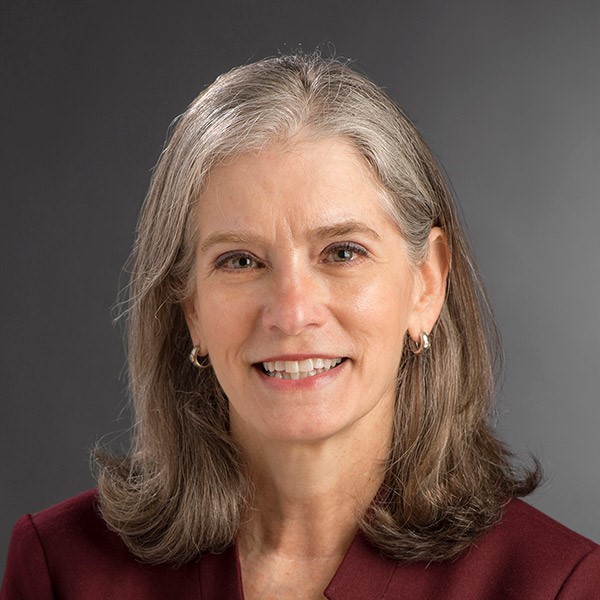Wendy Gelbard

Dr. Wendy Gelbard is Senior Associate Vice President, Wellness, RIT Student Affairs.
I am a physician with a background in General and Microsurgery Surgery, as well as Emergency Medicine. My path to medicine was odd in that I am a college drop-out. When I returned to my studies, I majored in Economics and Romance Languages – not the usual pre-med route. After 25 years in Emergency Medicine, most recently as Chair of Clinical Operations at University of Rochester Medical Center, I came to higher education motivated by the desire to shift from acute emergent care to prevention and maintenance of health and well-being.
1. How do you teach or exemplify Applied Critical Thinking?
While not in a formal teaching role at RIT, critical thinking is at the heart of how I approach my role as the Associate Vice President of Wellness within Student Affairs. When I entered medical school, I assumed if I studied hard, memorized all the important equations, and dutifully learned gross anatomy, I would have ALL the tools needed to become a great doctor. Not true. Medicine is far from an exact science. Patient illness evolves and treatment modalities are constantly changing due to active research and the acquisition of new knowledge. Medicine requires the gathering of available information and knowledge, applying it to unique patients, and being open to changing course direction when new data surfaces. Each patient brings their own personal history, lifestyle, and environmental influences. No assumptions can be made given past professional experience, as each individual patient has their own story.
I work with patients to create the solution most appropriate for them. As a surgeon performing reconstruction after trauma or illness, I gathered relevant information and worked with patients to meet their needs; THEIR needs, not mine. In the Emergency Department, time was a critical component of the process; triage, determining the hierarchy of emergent/urgent medical issues, was front and center. At RIT for the past seven years, it has been different. Rather than working with a single patient, I work with a unique group, our RIT student body.
There is rarely ever a single right answer. Every situation includes a unique person or group of persons: their personal situation, their medical profile, their physical and emotional state, their environment, and their support system to name a few components. It is not solely about knowing the facts. It is more about using the facts to make the right decision. To me, that is the essence of critical thinking.
2. Why do you think Applied Critical Thinking is important in your domain or role?
Addressing diverse needs of a large student body with varied health and wellness concerns demands the constant ability to sort and prioritize. Which issues need to be addressed immediately, which require iterative evaluation to arrive at the best outcomes for students, and which staff member is best suited to administer particular programs and services? RIT has generously supported the growth and development of Wellness on campus, and we have gathered together an amazing group of professionals. No one person can have the knowledge and ability to serve all aspects of well-being. Our Wellness leadership team regularly meets to review current campus community issues, successes, and failures. As a team, we review and assess campus needs. When those needs are identified, we must collect information that is often new to us and figure out how it applies to our students. We share our findings and use our collective knowledge and experience to make choices and choose paths forward. With a large group such as ours, communication and open-mindedness are essential. We do not always walk into the room with the same idea, but we make our best effort to leave the room on the same page. It is that sharing of ideas and information that allows us to move forward in the most positive and effective manner.
3. Can you share a story where quality Applied Critical Thinking was key to your success?
When I first started at RIT, the Assistant Vice President of Wellness told me of a student with an eating disorder, about whom she was concerned. We brainstormed treatment and care solutions. The very next day, the then Director of the Student Health Center shared with me that he had sent a student to the hospital – a student with an eating disorder, it was a different student. That afternoon, I walked across the hall to ask the Counseling and Psychological Services Director if their team saw students with disordered eating; he told me yes. I pulled those three leaders together to discuss our care of students who were experiencing disordered eating. They had not before discussed the intersectionality of their care, and from those early discussions we developed a multidisciplinary approach to the care of our students with disordered eating. From there, we continued to move forward with integration of student care in Wellness across many different areas. We now speak of our center as offering “integrated health services” thanks to the coming together of our Wellness teams.
4. How do you use critical thinking in other areas of your life outside of RIT?
Life outside RIT is similar to life inside RIT. There are always many balls in the air, and I constantly reevaluate options as they present themselves. I endlessly evaluate which is the best weekend hike closest to my favorite ice cream vendor, how many times can I toss the ball to my dog before she collapses of exhaustion but after she is ready to go inside, and which home improvement project will I not complete on Sunday.
5. Any last critical thoughts?
Never lose sight of the importance of how critical thinking shapes our lives in the midst of information overload.